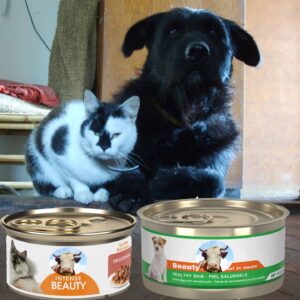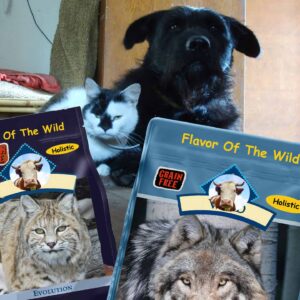Are Pet Food Preservatives Dangerous?
Ron Hines DVM PhD
 Cooking your pet’s meals at home
Cooking your pet’s meals at home
 Health issues sometimes associated with store-bought pet foods
Health issues sometimes associated with store-bought pet foods
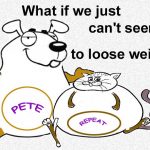 What if we can’t seem to lose the weight?
What if we can’t seem to lose the weight?
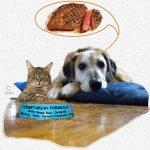 I’m a vegetarian or a vegan. Shouldn’t my cat and dog be one too?
I’m a vegetarian or a vegan. Shouldn’t my cat and dog be one too?
Why Do Pet Food Companies Add All This Stuff To Their Products?
Pet foods that are sold in cans, rely on the sterility of the can to protect the product from spoilage or in deterioration of essential nutrients. Most of the non-nutritional additives are added to improve the product’s appearance. Things like Carrageenans and Cassia Gum and gelatin, powdered wood & cotton cellulose, corn starch, guar gum, and carob bean gum to disguise the amount of tap water (70-80%) that you just purchased. These products do, however have legitimate uses in the sewage industry (read here) Coloring agents are also added for eye-appeal. That is for your eye appeal – not your dog or cat’s. As far as we know, dogs and cats are dichromatic. They perceive colors differently than we do. So cat and dog food manufacturers ad FD&C dyes and ingredients such as turmeric, and Curcumin to give the can contents a rich brown color. Although their labels do not indicate it, most of their cans might no longer be lined with BPA. In 2017, they did. (read here) Generally, pet food companies highly publicize changes that the public might perceive to be positive. I know of no major cat or dog food company claiming that their products are BPA-free. What all these unnecessary sales gimmicks do over time while combined in the can is completely unknown. What is obvious is that these products are a far cry from what God and Nature intended our dogs and cats to eat.
Cat and dog foods sold as dry kibble are an entirely different story. Even though those products are marketed as being “dry” for convenience and shelf life, they generally contain about 10% water. Even the wood you purchase at Lowes or Home Depot is about 14.3% moisture. Over 18 days from the time of manufacture, the loss of dry dog and cat food nutrients is substantial. (read here) Once you open the bag, home humidity increases the moisture content of the kibble, speeding loss and contamination. 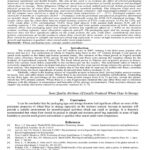 . So pet food manufacturers rely on a number of chemical preservatives to prevent spoilage and deterioration. They cannot lower their kibble’s starch/carbohydrate content easily because these extruded and baked products rely on carbohydrates as a binder (glue) to hold the individual pellets together. It also expands upon cooking making each pellet take up more space in the bag you just bought to appear you purchased more than you did. (read here) Their advertising departments, using focus group sessions, have, however, found that pet owners are less likely to become alarmed if they substitute the carbohydrates in peas and potatoes or put the words “whole grain” before the carbohydrate’s name. They have also learned to game their product ingredient list by dividing up portions of what, in reality, is a single ingredient. Dogs and cats have no nutritional need for starch/carbohydrates – nor for vegetables. In order to disguise the bland starch/carbohydrate and non-meat ingredients taste, an oily residue from the meat processing industry, along with rendered animal fat is sprayed on the biscuits after baking. That is what accounts for your greasy hands after filling your pet’s food dish. The other important reason lots of starch/carbohydrates are added is for greater profitability. According to the USDA, dressed beef at an Iowa slaughterhouse (similar to what you see on the sac of dry dog kibble you purchased) brings $7,192/ton ($3.59/lb) in mid-2022. Choice Midwestern corn at the Iowa Co-ops in mid-2022 sells for $160.00-165.00 per ton (less than 9 cents/lb). The major dog and cat food manufacturers sell lots and lots of tons of their products. However, when you expose oily meat or fish products to the air, the oil tends to degrade (lipid peroxidation). In the process, the oils produce rather unhealthy byproducts. (read here) So to retard oxidation, the makers of dry dog and cat foods add many antioxidants. There is nothing wrong with antioxidants. Your body even produces a few including glutathione peroxidase and superoxide dismutase to ward off oxidative damage. One of the antioxidants added in liberal amounts to dog and cat food, α-tocopherol acetate is actually desirable, it is vitamin E which is essential to dogs and cats.
. So pet food manufacturers rely on a number of chemical preservatives to prevent spoilage and deterioration. They cannot lower their kibble’s starch/carbohydrate content easily because these extruded and baked products rely on carbohydrates as a binder (glue) to hold the individual pellets together. It also expands upon cooking making each pellet take up more space in the bag you just bought to appear you purchased more than you did. (read here) Their advertising departments, using focus group sessions, have, however, found that pet owners are less likely to become alarmed if they substitute the carbohydrates in peas and potatoes or put the words “whole grain” before the carbohydrate’s name. They have also learned to game their product ingredient list by dividing up portions of what, in reality, is a single ingredient. Dogs and cats have no nutritional need for starch/carbohydrates – nor for vegetables. In order to disguise the bland starch/carbohydrate and non-meat ingredients taste, an oily residue from the meat processing industry, along with rendered animal fat is sprayed on the biscuits after baking. That is what accounts for your greasy hands after filling your pet’s food dish. The other important reason lots of starch/carbohydrates are added is for greater profitability. According to the USDA, dressed beef at an Iowa slaughterhouse (similar to what you see on the sac of dry dog kibble you purchased) brings $7,192/ton ($3.59/lb) in mid-2022. Choice Midwestern corn at the Iowa Co-ops in mid-2022 sells for $160.00-165.00 per ton (less than 9 cents/lb). The major dog and cat food manufacturers sell lots and lots of tons of their products. However, when you expose oily meat or fish products to the air, the oil tends to degrade (lipid peroxidation). In the process, the oils produce rather unhealthy byproducts. (read here) So to retard oxidation, the makers of dry dog and cat foods add many antioxidants. There is nothing wrong with antioxidants. Your body even produces a few including glutathione peroxidase and superoxide dismutase to ward off oxidative damage. One of the antioxidants added in liberal amounts to dog and cat food, α-tocopherol acetate is actually desirable, it is vitamin E which is essential to dogs and cats.
With the exception of a specific vitamin E (α-tocopherol) and vitamins A in cats or carotenoids in dogs, pet food companies are not putting antioxidants in their products to benefit your pet’s health. The natural vitamin E content of meat and meat byproducts are low. It is higher in grain and plant oils. However, the temperature required to bake cat and dog kibble destroys most of it. So, the manufacturers add a lot hoping that sufficient amounts will survive in their finished products. Other commonly used preservatives approved by the AAFCO and FDA for use in the pet food industry include sodium tripolyphosphate, ethoxyquin, propylene glycol, benzoic acid, BHA, BHT, Sodium bisulfite, Potassium sorbate. Vitamin C (ascorbic acid) is also added as a preservative. Pet food manufacturers know that dogs and cats do not need vitamin C. They know that dogs and cats make their own. see here:  The vitamin C added is not from squeezed lemons. (read here)
The vitamin C added is not from squeezed lemons. (read here)
What Are Some Of The Potential Dangers Of Food Preservatives And Additives?
All preservative compounds in pet foods that prevent, spoilage and microorganism growth interfere with cellular metabolism in one way or the other. The cells of your pet’s body share many of the processes found in these microorganisms. What one hopes is that the amounts found in pet foods are not enough to cause damage. You can read about their potential to damage the body here, here and here. When those compounds are tested by the FDA or the EFSA, the tests are for acute (immediate) toxicity, not for the long term, chronic effect of eating small amounts of these chemicals day-after-day, year-after-year. Read about that here, here, here, here, here. here, here, & here. Spoilage occurs in two ways, natural oxidation of ingredients and bacterial deterioration. Common food preservatives inhibit both these processes. In the process (similar to that of antibiotics) they also kill bacteria essential for your pet’s good health. (read here, here & here)
What Is The Best Thing For Me To Do?
I believe that the safest thing you can do for your cat or dog’s long-term health is to purchase the individual components of your pet’s diet on the same supermarket isles that you purchase your own food. Forget the pet food aisles, there is nothing there worth purchasing. Read about that here. Obtaining unbiased information regarding health risks related to what you feed your dog or your cat is difficult. In my opinion, you are not going to get unbiased information from pet food manufacturers, the ingredient labels on their bags and cans, their trade association, the AAFCO, the FDA or the veterinary school “studies” they helped pay for. (read here & here) The global pet food market is valued at ~ $99 billion in 2022. The pet food industry is strictly profit-driven. Their goals and your goals are not the same.
You are on the Vetspace animal health website
Visiting the products that you see displayed on this website help pay the cost of keeping these articles on the Internet.


